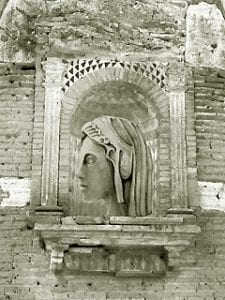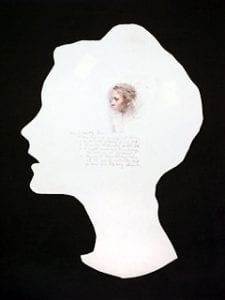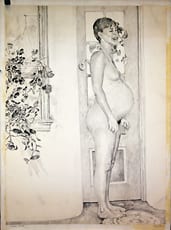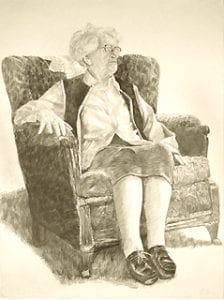
- This event has passed.
Lucy Gans: DRAWINGS AND SKETCHES
August 29, 2007 - October 28, 2007
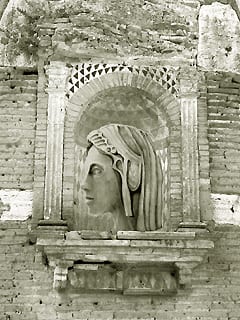
Reception for this exhibition and Lucy Gans: In Our Own Words: Friday, September 7 from 3-5pm. Main Gallery, Zoellner Arts Center.
Women in the Arts Panel Discussion with Janet Fish and Lucy Gans: Thursday, September 27 from 4:30-6:00. Moderated by Silagh White, ArtsLehigh. Reception to follow, 6-8pm. Main Gallery, Zoellner Arts Center.
Lucy Gans is Lehigh University Professor of Art, and teaches Sculpture, Drawing, and Women’s Studies.
She has been doing research into violence against women, specifically rape, incest and domestic violence, including battery and mutilation. The intent of this room of faces is to remind us of the overwhelming pervasiveness of the crime. Color is used to represent both age and race.
Statistics have been culled from the Federal Page of Statistics of Crimes of Rape and Sexual Assault, and from Turning Point’s records of Domestic Violence. An audio specialist has been consulted to record and project these women’s voices within the installation. They are to be heard as a quiet murmur, just above a whisper, to which one needs to stop and listen.
The installation consists of over 400 ceramic heads, painted and glazed. originally carved in wood, they are meant to represent different female racial types, but the feautures are intermixed so that all the faces seems similar.
Conversation with Artist and Curator
Ricardo Viera: The exhibition is composed of two distinct bodies of work, the main gallery at Zoellner having an installation, and at Girdler, an exhibition of your drawings. What is the conceptual difference or vision between these two groups of works for you as a consummate educator and practical artist?
Lucy Gans: I think of myself as a sculptor who makes drawings. My work has always been figurative. The installation is a project I have been thinking about for a long time. The original pieces were carved in wood, and meant to represent different female racial types, yet the features are intermixed so that all the faces seem similar. I then manipulated them through molding and casting to create this wall of faces. I am looking for some broader significance in my sculptural work, some degree of social significance, in this case attention to Domestic Violence. The work in Girdler shows my concern for the figure over a period of time. There is no focus other than different ways I have looked at the female figure over the past 20 years. It is more about the way I use it to present an idea than about the way I see it.
RV: What is art to you, and how to you bring that to the classroom?
LG: I have to work with my hands; I am one of those people who have to touch everything, not just lightly, but pick it up, move it around and somehow manipulate it. Haptic, I guess you call it. I use the work to ground me, as my guide wire. Art is the way I negotiate my way through my life. What I do in the “classroom” is different. First, I expect that what students are doing in my studios is the most important thing they have to do all day. Although I try to guide my students through the acquisition of skills and ideas, I force them to both complete their projects, drawings, sculpture and make them talk about it. I stress the importance of the relationship between the acquisition of hand and eye coordination along with cognitive and verbal skills. For myself, my work is always in the state of becoming. Half of those drawings in Girdler are still in process, and this installation could go on and on. And I find talking about my own work very uncomfortable, but perhaps this is because I spend all day in class talking to students about their ideas and pushing them to follow through with them.
RV: You are known in academia as a studio person who teaches sculpture and drawing, as well as a professor of theoretical aspects of women’s studies. How has that contributed to your development as an artist?
LG: I cannot separate myself from my work. My research informs my practice and my practice directs my research. I come to both the studio and the classroom as a woman, as a feminist, as an artist and as an educator. I work from my personal experience and I find I respond more to the work of artists who also work that way. In my work in the women’s studies program I was pushed to do research into women’s lives and the institutions that shaped them, not just as art and artists. Each one of the subsequent issues I have explored through my work came from some of that women’s studies research: body image, rape, incest, and now intimate partner violence. I think that the formal study of feminist theory has changed the way I teach and the way I approach my work in the studio.
RV: How has art changed throughout your years as an artist and educator? Are we truly learning how to see, or are we still looking?
LG: How has art changed in my lifetime? What a question. The biggest change I have noticed is the expectation that newer is better, that younger is better, that edgy means ugly, and that there is no right or wrong way to approach art making. If you haven’t “made it” by the time you are thirty then quit and get a real job. And I think we will always redefine both art and seeing. And no, people still don’t know how to really look at art, much less at the world around us. We are used to the quick take; we look more but are seeing less.
RV: Tell us about this installation. This is a theme you have pursued and continued for several years. Do you want the viewer to discover on their own, or is there a specific message? From a technical point of view, how did you select the media of the ceramic and multimedia overall component?
LG: I originally planned an installation that dealt with the invisibility/visibility of race. The faces I work with are iconic, archetypal. Not specific just as my “skin tones” are not natural. But this installation is about how pervasive domestic violence is today. How it crosses age, race, economic and ethnic borders. She could be a mother, a sister, a daughter, a granddaughter, a niece, an aunt, a grandmother, stepdaughter, stepmother. She could be your friend, your co-worker, a classmate, the woman behind the desk as well as the woman in front of the counter. Most incidents go unreported. Most women think that is they stay they can change his behavior, they stay for their children, they stay for their parents, they stay because they are afraid to leave. That is my message. Listen to their voices. We just need to know how to help. My next project is more of the same. My next step is to take this to different communities and record their voices.
RV: What is your next project? What kind of research as an artist/educator are you pursuing?
LG: Just as I enjoy layering my meanings I enjoy layering my images. I am researching the bad girls in history, ones that have been misrepresented, both
real and mythic, and trying to tell their stories. Hagar is my first; I have started several drawings and carvings. I think I am calling it “Whores of Babylon” but I am not sure; it is still early and I work very slowly.
RV: Who is Lucy? The person, the artist? Is it hard to separate them?
LG: I am 57 years old, a wife, mother, sister and daughter, and I have been making sculpture since my senior year in college, 1970. I have also been teaching sculpture and drawing full time for over thirty years, twenty-five of them here at Lehigh. Throughout my life as an artist I have been aware of social issues, but it was not until my work became fully figurative that those issues were represented in my work. I also think motherhood has affected my work and its mission.
RV: How is that?
LG: I have two children, so somehow it was important that I focus on women’s position in society, and the institutions that shape their lives. I looked at their representation in art and in popular culture, and examined the standards of beauty, how it adversely affects women. This exhibition is concerned with women and girls that have been victims of domestic violence. Throughout my academic career at Lehigh University I have been involved with the Women’s Studies Program and that relationship has led me into research into women’s lives that I necessarily would not have encountered as an artist. Each installation that I envision somehow needs to deal with some of these issues out in the open, for all to see. This will be the direction of my work for the next few years.
RV: Your contribution to the visual arts has been significant, as well as a pioneering role in women’s studies at Lehigh.
LG: I started teaching at Lehigh in 1981 and have taught 3-D Design, 2-D Design, Painting, Drawing, Sculpture, Figure, Introduction to Art, Women in Art, Seminars in Contemporary Art and Introduction to Women’s Studies. I have been the Chair, and Interim Chair of the Department of Art & Architecture, Director of the Women’s Studies Program and served on the advisory councils for Women’s Studies, The Eckhardt University Scholars Program, ArtsLehigh, Design Arts and the Women’s Center, as well as serving on the educational committee at the Allentown Art Museum.
RV: How about your trajectory as an artist?
LG: I have exhibited my work all over the country, primarily in alternative spaces, women’s cooperative galleries, college and university galleries and small museums. I have received several grants, awards and fellowships, most recently a two-month fellowship at the Vermont Studio Center where I started on the new series of drawings and sculpture.
